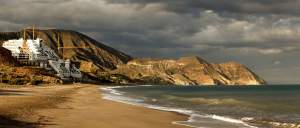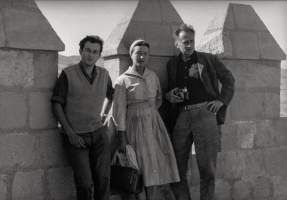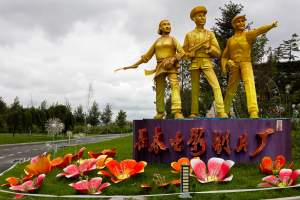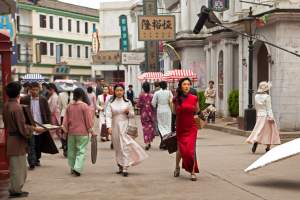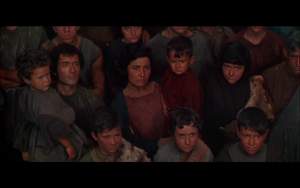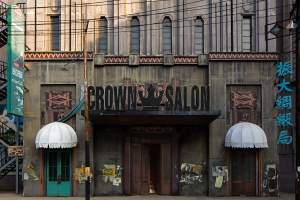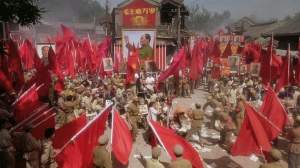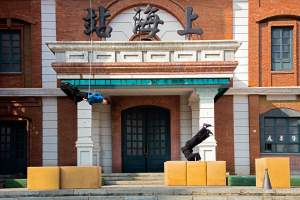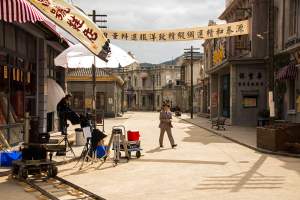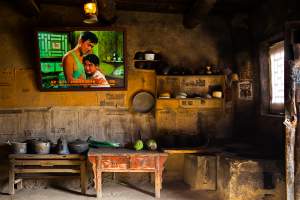Blog
Then and Now: The Attack on Aqaba
Compare the beach at Algarrobico on the southern coast of Spain then and now in the video clip above. The city of Aqaba was reconstructed here in 1962 for the filming of this classic scene from Lawrence of Arabia. Though nothing remains of the set today, just the hulk of an abandoned hotel project. I previously wrote about the history of this spot on this blog here.
Read MoreNelson Algren and Simone De Beauvoir’s Road Trip Through Franco’s Spain
Only a handful of photographs exist of Simone de Beauvoir and Nelson Algren together from a love affair that persisted, mostly across the Atlantic ocean, for over a decade. Possibly the last photograph of them together is from a visit to Spain in May 1960. In the photograph, they stand with Catalan writer Juan Goytisolo to their right along the wall of the Alcazaba, an old Moorish palace, in Almería. A glimpse of the mountainous landscape beyond can be seen over Goytisolo’s shoulder. Beauvoir, in the middle, looks intently into the camera with the air of a school teacher, while […]
Read MoreChangchun Film Studio
The Changchun Film Studio was the first official state-run film studio recognized in the People’s Republic of China. It was created through merging multiple existing film production facilities and, in 1955, was given a permanent home in Changchun. For several decades, the studio occupied a cluster of buildings which had been constructed under the Japanese occupation to imitate the German Ufa Film Studio. The studio reportedly produced over 1000 feature films over the years. The film Bridge was made here in 1949, the PRC’s first feature film, which told the story of a worker who inspires his comrades to finish […]
Read MoreHengdian: The World’s Largest Film Studio
Xie Jin was one of the most important film directors of the Communist cinema generation working in the 1950s and early 1960s. His 1965 film Two Stage Sisters would later go on to receive international acclaim, but at the time, at the start of the Cultural Revolution, it was attacked for purportedly promoting bourgeois values. Xie was eventually rehabilitated and went on to make other important films, including Legend of Tianyun Mountain and Hibiscus Town. In 1995, Xie, now in his 70s, was scouting locations for a State-supported historical epic titled The Opium War. With a budget of $15 million, […]
Read MoreSpartacus: Between Spain and Hollywood
Spartacus was supposed to be filmed entirely in California. By 1960 there was growing alarm about the impact of “runaway” productions, which sought to cut costs by filming overseas, on Hollywood. Edward Muhl, longtime production director for Universal Studios, which was financing Spartacus, sought to demonstrate that an epic film could be made entirely in the US. Kirk Douglas, both producer and star, brought on a young Stanley Kubrick to direct (after firing Anthony Mann from the job). Kubrick, however, wanted to film in Europe. In the end, while the interiors and much of the first half of the film […]
Read MoreRepublic of China on Taihu Lake
The awkwardly named ‘Jiangsu West Taihu Lake Film and Television Industry Base‘ in Changzhou, northwest of Shanghai, is relatively new, established in 2015. It reportedly cost over $110 million to build and includes 7 indoor sound stages and 150 acres of outdoor sets and other facilities. The site is especially known for its use in Republic of China era TV series, and most of the outdoor lot consists of streets of early 20th century urban streetscapes. The 2019 film Liberation, which received a very limited US release in January 2020, was made there, along with TV dramas Detective Ke Chen […]
Read MoreFarewell My Film Studio
The Beijing Film Studio was created in 1949 as one of the primary state-run film production facilities. The studio was responsible for classic films such as New Year’s Sacrifice (1956) and Song of Youth (1959). Later, the studio constructed a traditional Chinese streetscape on a backlot near the university district in Beijing, reportedly used for 1982 films Rickshaw Boy and Teahouse. It also became the first studio to open up to international co-productions with Bernardo Bertolucci’s The Last Emperor in 1987, which also received permission to film within the Forbidden City. In the early 1980s, former Taiwanese film star Feng […]
Read MoreHuzhou Film and Television City
Huzhou Film and Television City, located within the Taihu National Tourism Resort, is just as much about family entertainment as it is about film production. When I visited, the entire park staff assembled out front for a song and dance routine before the doors opened. Tourist shows occur throughout the day, including an acrobatic police chase (pictured), axe gang choreography inspired by Kung Fu Hustle, and a fictional wedding ceremony. The first portion of the park, representing Republic of China era Shanghai, was constructed in 2016. It includes the Bund, a port, a Catholic church, and other large scale buildings. […]
Read MoreXiangshan Film and TV City
The Xiangshan studios opened in 2005 on an undeveloped peninsula of fishing villages south of Ningbo for The Return of the Condor Heroes (2006), based on the Wuxia novel by Jin Yong. The site was also used for Chen Kaige’s historical drama Sacrifice (2010) and for the popular TV series Nirvana in Fire (2015). A Republic of China section added later was used in the ill-fated WWII film Air Strike with Bruce Willis. The production was hampered by delays, cost overruns, and a tax evasion scandal involving actress Fan BingBing before it was widely panned by critics.
Read MoreZhenbeipu Western Film Studio
Constructed on the ruins of an old fortress outside Yinchuan in northwestern China near the edge of the Gobi desert, the Western Film Studio has been used in numerous epic historical films. Writer Zhang Xianliang first had the idea to use the site as a film location after spending time laboring on a nearby farm during the Cultural Revolution. The 1982 film The Herdsman, based on a story by Zhang, was the first feature film made here and one of the first Chinese films to get international recognition. Other noteworthy films shot here include Zhang Yimou’s Red Sorghum (1987), Hong […]
Read More